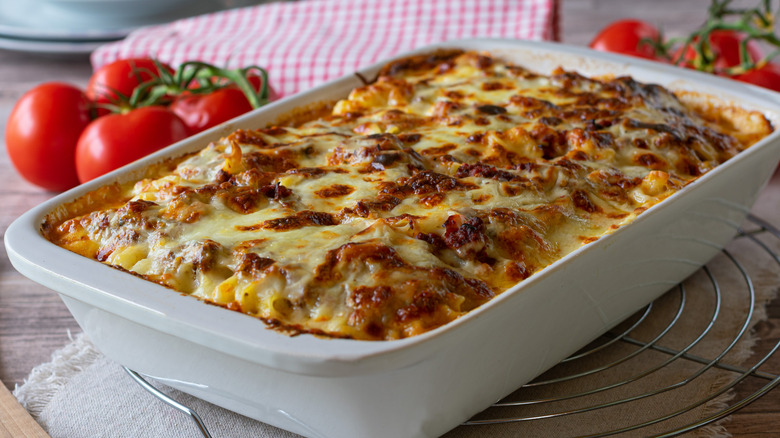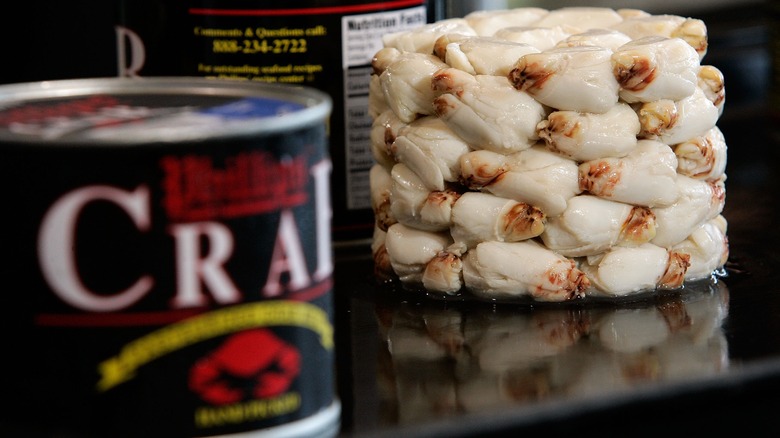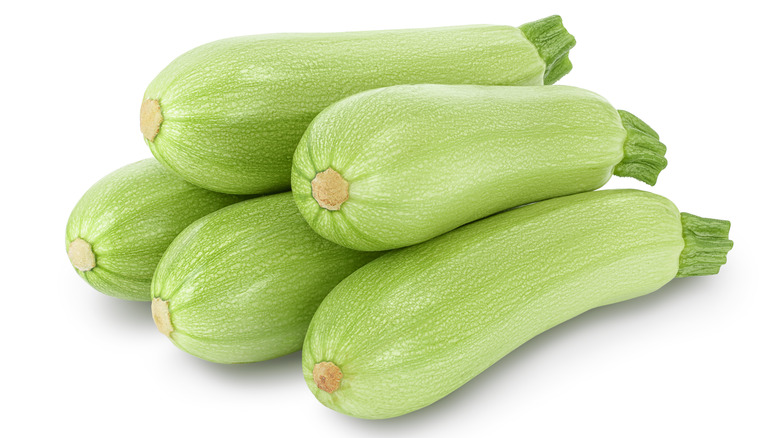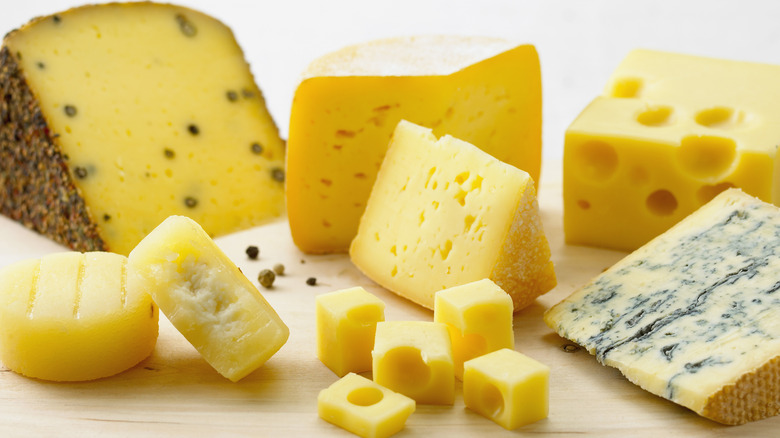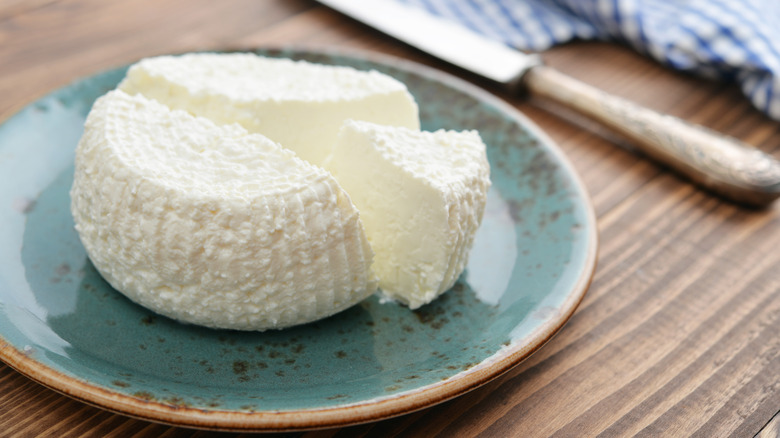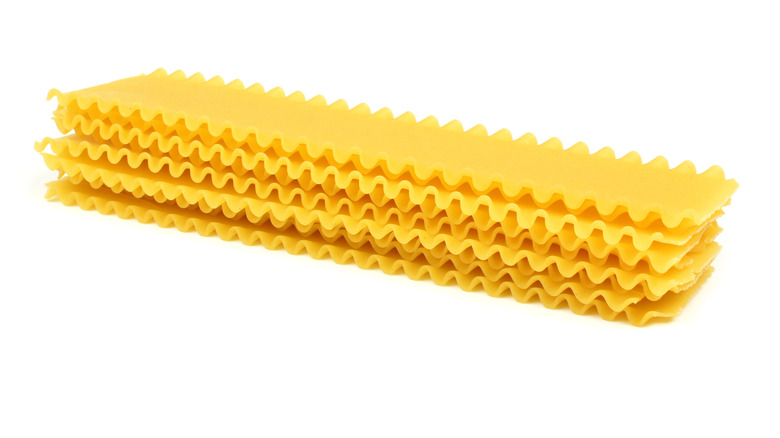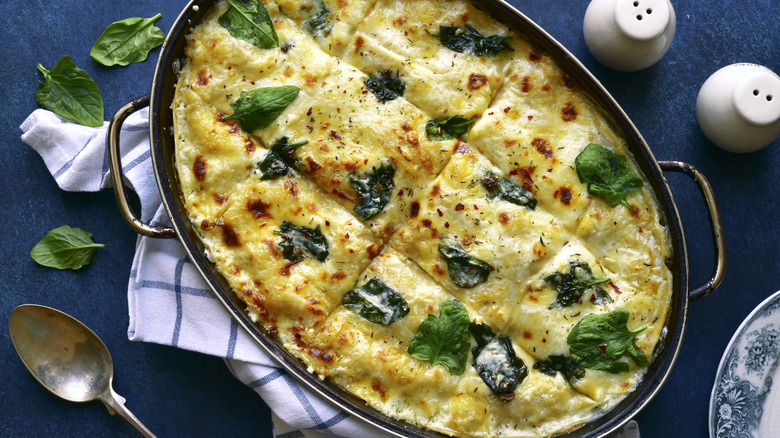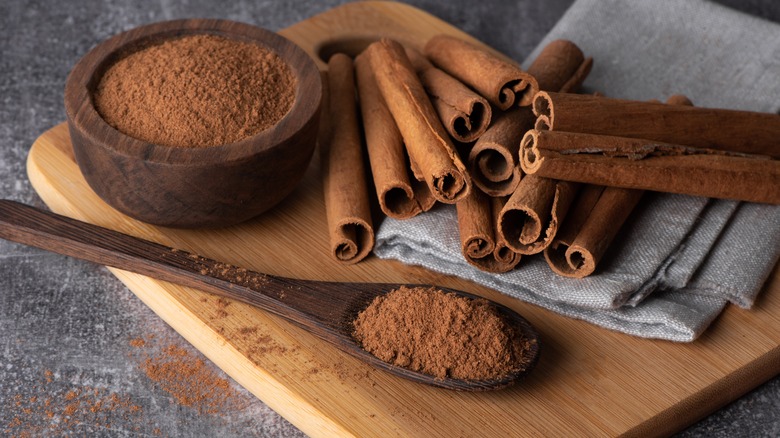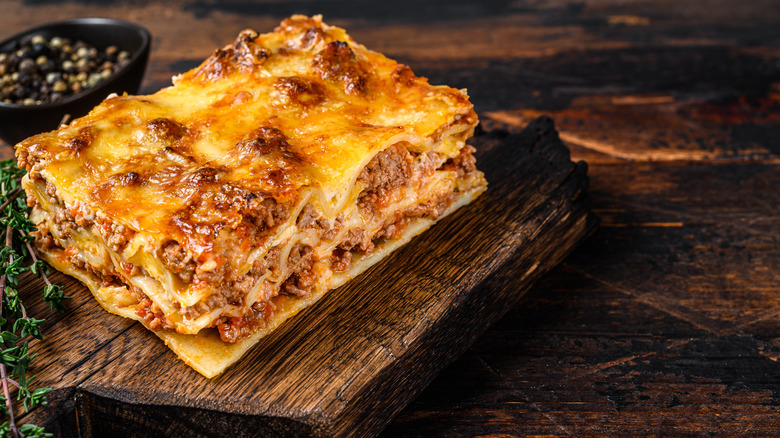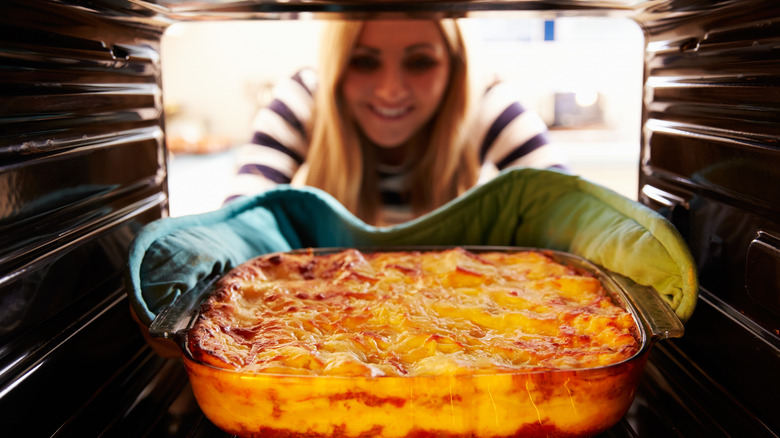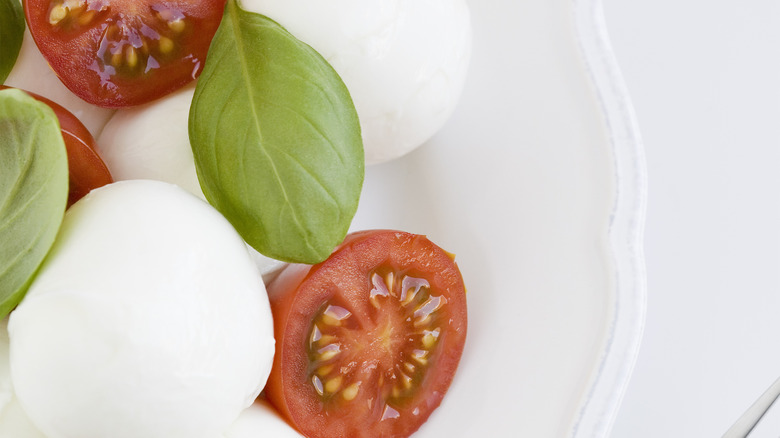11 Ways To Add More Flavor To Your Homemade Lasagna
Lasagna might be the ultimate comfort food. The layers of gooey, dripping cheese, the thick, robust helpings of meat and other delectable goodies, and the sheets of wonderfully unique pasta blanket the entire thing together. It's a food lover's dream.
However, you've probably been to your fair share of potlucks and have sampled a few less-than-desirable helpings. Beyond the fact that you know Susan from HR is just masquerading a store-bought lasagna as her own by slipping it into a baking dish, many simply leave far too much to be desired. The noodles are too limp, the sauce and meat are mild, the cheese is as bland as cheese can be, and, for some reason, the entire thing is damp, like someone spilled their water onto the lasagna before serving it.
Not to worry, though. Whether it's your own lasagna that needs a little pick-me-up, or you want to share some secret cooking techniques to help out others you know are suffering, we are here to help. To assist you along the way, here are several ways you can take your lasagna from bland to glam in no time. We'll make sure your dish becomes the talk of the town, so everyone is craving it the next time you show up with your world-famous lasagna.
Diversify your sausage
Nothing takes the same old-same old lasagna recipe to new heights than diversifying the sausage spread. We're not saying you need to totally ditch the current sausage you have, but cut it in half and bring something new in. Maybe it is time to bring that spicy Italian sausage in from the bench, or if you really are into spicy pork sausage, you might want to grab a few links of chorizo sausage to test out. We've found one of the best ways to make eyes pop and for people to ask what you did with your delicious lasagna is to have a new meat blend.
Is chorizo or spicy Italian sausage a bit too much fire for your taste buds? Reach for a kielbasa. Sure, it may be a dollar or two more than most regular sausages, but the flavor here is truly on point. There are so many sausages to experiment with, and it will help you customize your dish until it perfectly fits your taste buds' needs. All of this is what makes lasagna beautiful. You don't have to exactly follow the recipe (just don't tell your Italian aunt this, because she might give you a death stare tomorrow). But tweaking and testing different meats can truly add a wow factor to your dish.
Sswap out that sausage for seafood
Maybe you really want to get freaky with your lasagna. Who says you can't test out some seafood instead of meat? It brings an entirely new complexion to your plate, and, in no time, it can give the entire family a new favorite. We love it because it transforms the dish and makes it fresh again, as the seafood and meat options are so different.
With seafood lasagna, you want to swap out the meat with something that blends well with the sauce and cheese, and, almost more importantly, absorbs some of the liquid that might run off. Our favorites to consider are crab and shrimp meat. Crab meat is already on the milder side of the taste spectrum and can fully take advantage of the other flavors around it. Heck, you can even spring for lobster if you feel like treating yourself.
Using seafood in your lasagna opens you up to entirely new options as well. Instead of a red marinara sauce, you can use a white sauce instead. The creaminess of the white sauce perfectly blends with the cheese and the seafood mixture. It's a new take on lasagna you might not have considered before, but if you're feeling a bit bored with what you are making, we do highly suggest it (just make sure to check with any guests if they have seafood allergies).
Reconsider the veggies you're using
Perhaps you are a vegan or vegetarian looking to make lasagna and, for whatever reason, it keeps coming out soggy. This is probably because of the vegetables you're using. Just about every kind of vegetable you use will have some self-contained moisture locked in, and, as it cooks, the moisture will escape. Because there isn't anything porous in the food, there isn't anywhere for that excess liquid to go than the bottom of the pan, and that just starts to soak into the pasta (yuck).
So how do you correct this problem? Pay closer attention to the veggies you are using. For one, if you're using zucchini, which is a classic meat alternative, slice the zucchini thinly top to bottom, and then sprinkle them with salt for at least 15 minutes before you cook with it. This will help draw out excess moisture. Finish it by dabbing the moisture off with a paper towel.
If you enjoy mushrooms in your lasagna, you should pre-cook them for a little bit. This will help pull out excess water before cooking. Because you are naturally going to have more liquid whenever cooking with vegetables, you should look for ways elsewhere to remove moisture. Cook down the sauce to thicken it up, and swap out fresh mozzarella with shredded, as both tend to come with their own moisture. This will give you a bit more leeway with your veggies.
Don't use the same exact cheese
Don't be like one of those "chefs" that just stack layer after layer after layer of the same ingredients on top of each other. That does nothing but hurt your jaw when you try to eat it (it also leaves you disappointed in the overall lack of flavor). With so many incredible cheeses in this world, it would be a crying shame to not spread the joy and bring some in. Cheese works so well on just about anything. And that includes trying out different cheeses on your next lasagna.
Why are there so many Italian cheeses? Because they all go amazingly well with pasta and tomatoes. Okay, so that's a little bit of an oversimplification, but, really, experiment with your cheeses and mix them up.
It's okay to go with something bolder, but maybe you're timid. You don't want to bake an entirely new lasagna only to find it the new cheese ruined it. Don't worry, just whip up a few spaghetti noodles and top it with a dab of marinara and the cheese in question. Does it taste good? Well, you have your answer. But there are lasagnas out there with a lot of different cheeses going on. You can always push the boundaries, as well.
Try ricotta cheese
This kind of cheese brings an entirely elevated level to your lasagna. The fresh yet somewhat spicy and tangy taste of ricotta can blend with everything in your lasagna. It sticks to the noodles and it bleeds beautifully with the sauce. Ricotta helps offset some of that Italian sausage spice and mellows everything out. This cheese should be the all-star center of your cheese lineup.
Ricotta is fluffy and almost frosting-like with a creamier texture than feta. It also tastes different from the other cheeses everyone is familiar with. Every Italian dish you get is already going to be loaded up on various forms of Parmesan, and, while we're not hating on Parmesan, sometimes your taste buds are craving something else.
Ricotta just takes this dish to an entirely different level. And, one tip — if you find that the ricotta is a bit too dry and isn't spreading as well as you'd like, you can cut it with some cottage cheese. Ricotta is like adding a nice soft pillow of cheese into the middle of your dish, and it lets everything become more relaxed and comfortable with one another inside the baking pan. Cottage cheese is already mild in taste so it will do little to dilute the ricotta, all while making it infinitely more spreadable.
Use no-boil noodles
Most pasta you use will require some kind of pre-cooking. That's not the case when it comes to lasagna. That is, as long as you purchase the right kind of lasagna noodles. Because there is so much going on over top the lasagna layers, the pasta itself will cook and become moist with the help of the cheese, the liquids remaining in the sauce, as well as any fat that might squeeze out of the pasta you're cooking with. Because of all this going on, you can skip cooking the lasagna noodles.
Just make sure to look for lasagna pasta that is clearly marked "no-boil" on the label. This pasta is made to handle less moisture. If you buy traditional "cooked" noodles, they will remain hard and too crunchy after you have finished preparing the meal. Additionally, if you boil your pasta ahead of time, you will already have al dente pasta, which is fine if you're making spaghetti and getting ready to serve. With lasagna pasta, you're still baking the dish for a while, and then some of those noodles will remain under seven or eight layers of other toppings, which results in damp and soggy noodles. So, do yourself a favor and replace your "must-cook" noodles with "no-cook" noodles.
Test out white lasagna
Just about every delicious food can have a dark side to it. It's that little nuisance that prevents far too many people from truly enjoying the food without breaking up in hives or having their stomachs cursing at them as it digests every bite.
You wouldn't think a bunch of tomatoes would be able to shred someone's stomach up, but, sadly, it's the truth. The acidic levels in tomatoes and tomato sauce can cause digestive issues. Now, sprinkling some sugar into tomato sauce is an old trick that works well with spaghetti sauce. That, however, doesn't necessarily work when it comes to reducing the acidity of your lasagna. There's just too much going on, between the tomato marinara and the sausages. All of that is a recipe for a delicious dinner and acid reflux for dessert.
So how do you go about fixing that? You can switch to white lasagna. With a white lasagna, you'll remove tomatoes from the dish, which instantly will significantly cut down the acidity levels of the meal. There are other meats you can use instead of the spicy Italian sausage (or sausage in general) if you would like. Ground turkey or chicken also works nicely. Or, as we mentioned earlier, you can opt for a seafood alternative. Just remember, if you have a dietary issue with lasagna because of the ingredients themselves, it's such an easy recipe that you can almost always make the needed corrections.
Consider cinnamon your secret ingredient
Cinnamon is such an underrated addition to so many savory recipes. It's truly incredible what it can do. A dash of cinnamon in a bowl of chili is enough to take it over the top. And if you can't handle straight black coffee but aren't feeling cream and sugar, reach for the cinnamon, as it can replace your sugar, and it's even good for your metabolism.
But cinnamon in lasagna? Yes, absolutely. And, sure, it might sound outlandish at first, but the cinnamon helps neutralize some of the spicy notes of your Italian sausage, and it blends wonderfully with a tomato based-lasagna (you can skip the cinnamon when cooking a white sauce lasagna).
Cinnamon does help blend with the acidity of the tomatoes. While it won't likely bring down any acid reflux you experience whenever eating a lot of tomatoes, it will help reduce some of the immediate taste, all while adding that subtle, underlying sweetness that works beautifully with robust marinara. Give it a try. Trust us, you won't be disappointed.
Don't skimp on the tin foil top
Lasagna is thick. One of the problems you run into when baking anything with the sheer size of a lasagna is the food not cooking all the way through. And is there anything worse than taking a bite out of a delicious-looking dish, only to have the middle give you frostbite? Okay, we can think of a few other worse things, but you get the idea. It's a quick way to ruin a delicious meal.
One of the problems with this is that the bottom will always cook faster, thanks to the base absorbing heat from the oven. And, yet, you can't add a physical top to lasagna due to the amount of moisture. You'll only trap all of that moisture inside the container, which would result in a gooey end product that doesn't have the kind of crispy noodle edges and perfectly rendered meat you'd like.
The tin foil helps alleviate all of these issues. With a tented tin foil top you'll keep more of the heat inside the casserole dish, which helps evenly bake the entire lasagna, all while allowing moisture to funnel its way out. This way, you'll help reduce the chance of producing a swampy lasagna and everything will be cooked entirely through.
Finish with the oven broiler
Do you want a little secret that will help give you that perfect final touch of crispiness to your lasagna? With five minutes to go on the timer, rip off the tin foil (use some gloves, of course), and then crank up the broiler. This will help give you that expertly baked, slightly crusted tips to the lasagna that you just can't get anywhere else outside of a blow torch. And who really wants to bust out the torch for lasagna?
If there is one device in your entire kitchen that likely goes underutilized, it is probably the broiler. If you have never turned the broiler on in your oven before, you wouldn't be alone. But now is the time to fire it up and give it a go.
The broiler will help rid any lingering moisture that's sticking to the surface. Just make sure you max the broiler time out at five minutes. Anything more and you run the risk of drying out and even burning the food. You've worked so hard to produce the best lasagna possible, no need to fall asleep at the wheel at the end and burn the dish.
Fresh is almost always better
When walking through the grocery store in search of your lasagna ingredients, it is almost always better to go with fresh over boxed, frozen, or canned. Of course, this does have much to do with your budget, but if it is possible, we highly recommended fresh. It makes a world of difference.
If you go with fresh mozzarella, you'll want to strain the cheese out with a cheesecloth. Mozzarella, to keep it from hardening, is packaged with water. The problem here is if you don't drain the cheese well enough, it will end up in the lasagna, which can cause moisture issues. Squeezing out the mozzarella with cheesecloth will still give you that same great taste, all without bringing in that undesirable water.
Also, consider fresh basil (if your recipe calls for it). Fresh herbs are a breath of fresh air in any recipe. You might need to tweak your recipe accordingly, though, especially if it asks for dried basil over fresh. Fresh will always have a more pungent, powerful taste to it, and if you add the same amount of fresh basil as you would dry, you might overpower the lasagna a bit.
